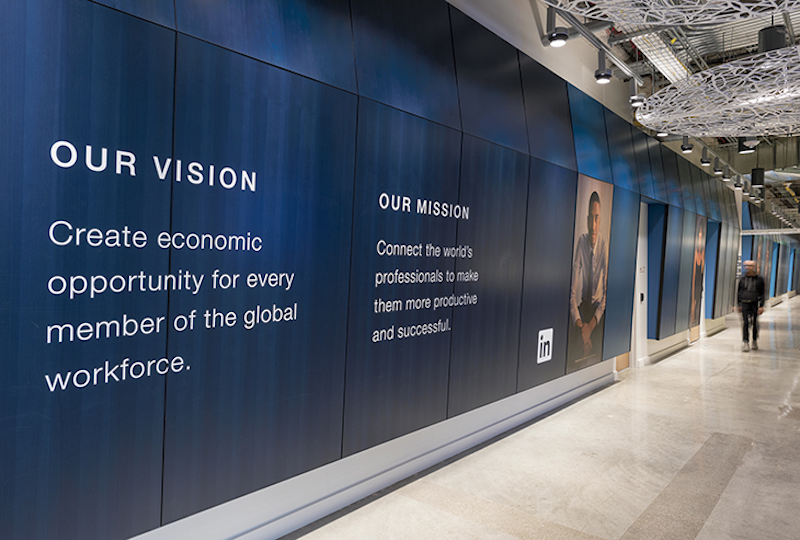We live in a time when the creative economy reigns supreme and most organizations view “creativity” as the most valued currency. We are seeing companies like Airbnb and Twitter led by creatives, and not just business grads. Companies are paying a premium to attract and retain employees who are smart and imaginative. The big question is, once you secure outstanding talent, how do you keep the creative juices flowing and help employees feel more connected to their company’s culture? Beyond wellness programs, transportation services, catered food & beverage, and other amenities, companies are creating enriching experiences and deeper engagement with employees as soon as they physically step into the office through unique brand touchpoints, called environmental graphics.
Gensler’s 2017 Experience Index indicates that there are five main modes people experience space through which include task, social, discovery, entertainment and aspiration mode. Environmental graphics are one way to make a good experience great, by introducing inspiration, meaning and purpose into the workspace, as well as brand authenticity. The findings indicate that “People are 10 times more likely to share their experience on social media” when spaces have unique design features, which is one of many reasons why environmental graphic design (EGD) matters.
 LinkedIn’s Silicon Valley headquarters. Image © Jasper Sanidad.
LinkedIn’s Silicon Valley headquarters. Image © Jasper Sanidad.Graphics must be specific and tell a unique story of what makes your organization tick. Graphic concepts have underlying themes often derived from mission/value statements, cultural tenets and brand personality traits. EGD helps employees connect to the company’s purpose; sparks creativity and enriched relationships between employees and with the organization itself; and reinforces the premium experience employers are investing in. According to Harvard Business Review, “You need to have employees who understand and embrace the distinct ways you create value for customers, the points that differentiate your brand from the competition, and the unique personality that your company uses to express itself.”
Gensler worked with LinkedIn to develop a dynamic EGD program to express their unique corporate culture. Using humor, wit, and a touch of weirdness, the graphics speak more directly to the impact LinkedIn has on its members. For LinkedIn’s Silicon Valley headquarters, Gensler created vibrant graphics in the lobby, cafes, work zones, socialization areas, and even restrooms—with phrases like “Better Together,” and “Change Is Good,” tying back to their cultural tenets. These graphics create Instagrammable moments where employees have commented about why they love coming to work every day, proof that graphic design goes beyond retention and recruitment, and is an essential platform for employees to share their story.
 LinkedIn’s Silicon Valley headquarters. Image © Jasper Sanidad.
LinkedIn’s Silicon Valley headquarters. Image © Jasper Sanidad.Mikhael Banut, LinkedIn’s Environmental Graphic Design program manager, notes, “The purpose of LinkedIn's environmental graphics program is to create a workplace that combines messages, images and tone that illustrate LinkedIn's vision. We believe we can inform and inspire employees about our company's brand, core values and culture within the workplace environment.”
Environmental graphics are a way to engage employees on a level that can be easy to overlook, physically in the workspace. They are meant to be tailored to help the space feel more like you and less like everybody else. It is a tool that can communicate your company’s “why” and what you believe in.
Jennifer Gebhardt is a regional Brand Design practice area leader and works with her clients to understand their culture and values. She communicates those ideals to both brand and workplace design teams, assuring brand is an essential piece of every project.
More from Author
Gensler | Apr 15, 2024
3 ways the most innovative companies work differently
Gensler’s pre-pandemic workplace research reinforced that great workplace design drives creativity and innovation. Using six performance indicators, we're able to view workers’ perceptions of the quality of innovation, creativity, and leadership in an employee’s organization.
Gensler | Mar 13, 2024
Trends to watch shaping the future of ESG
Gensler’s Climate Action & Sustainability Services Leaders Anthony Brower, Juliette Morgan, and Kirsten Ritchie discuss trends shaping the future of environmental, social, and governance (ESG).
Gensler | Feb 15, 2024
5 things developers should know about mass timber
Gensler's Erik Barth, architect and regional design resilience leader, shares considerations for developers when looking at mass timber solutions.
Gensler | Jan 15, 2024
How to keep airports functional during construction
Gensler's aviation experts share new ideas about how to make the airport construction process better moving forward.
Gensler | Dec 18, 2023
The impacts of affordability, remote work, and personal safety on urban life
Data from Gensler's City Pulse Survey shows that although people are satisfied with their city's experience, it may not be enough.
Gensler | Nov 16, 2023
How inclusive design supports resilience and climate preparedness
Gail Napell, AIA, LEED AP BD+C, shares five tips and examples of inclusive design across a variety of building sectors.
Gensler | Oct 16, 2023
The impact of office-to-residential conversion on downtown areas
Gensler's Duanne Render looks at the incentives that could bring more office-to-residential conversions to life.
Gensler | Sep 13, 2023
Houston's first innovation district is established using adaptive reuse
Gensler's Vince Flickinger shares the firm's adaptive reuse of a Houston, Texas, department store-turned innovation hub.
Gensler | Aug 7, 2023
Building a better academic workplace
Gensler's David Craig and Melany Park show how agile, efficient workplaces bring university faculty and staff closer together while supporting individual needs.
Gensler | Jun 29, 2023
5 ways to rethink the future of multifamily development and design
The Gensler Research Institute’s investigation into the residential experience indicates a need for fresh perspectives on residential design and development, challenging norms, and raising the bar.
















